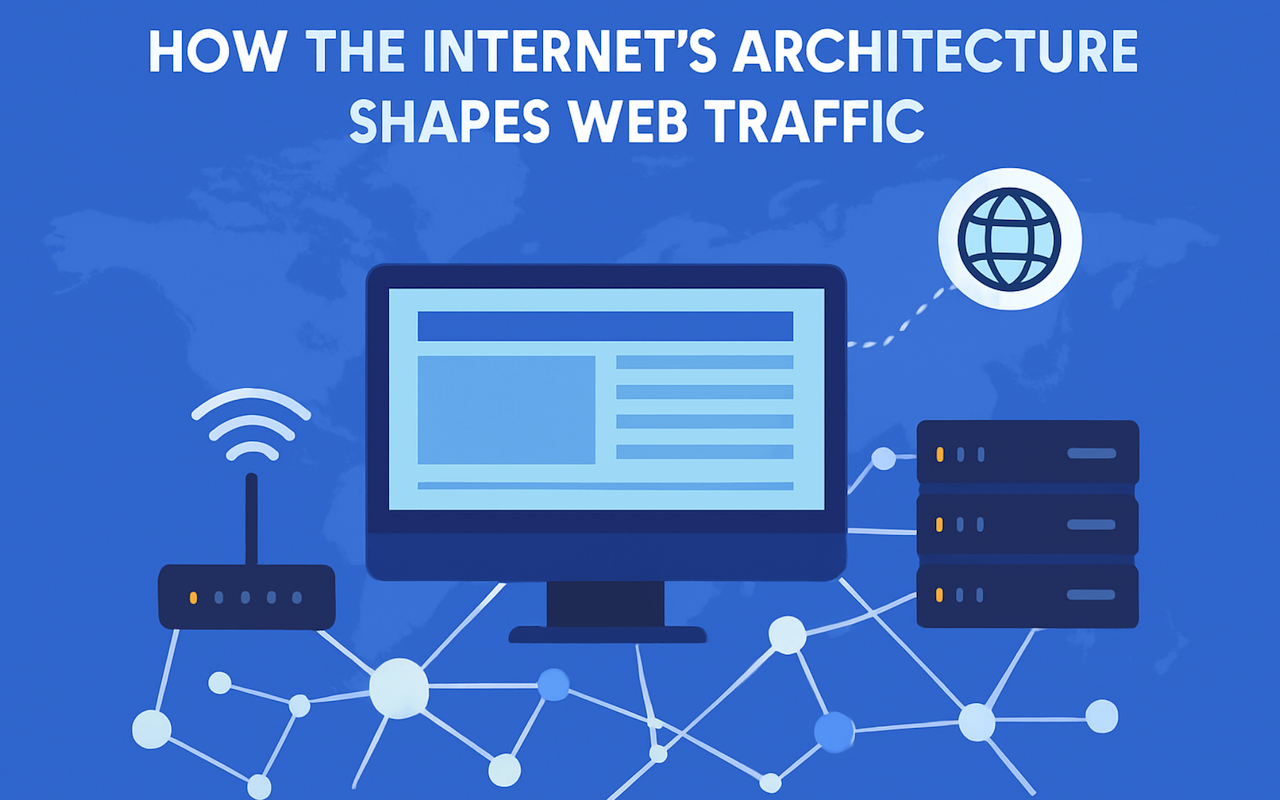
Although the internet has global coverage, it is far from a random or unstructured system. Its architecture—the design and organization of networks, servers, and data routes—plays a central role in shaping web traffic. The way the internet is built directly influences the accessibility of digital content, website speed, and overall user experience.
Internet Architecture
The internet is a vast system of interconnected networks linking millions of devices worldwide. Its multilayered architecture is organized into several functional layers:
- Physical Layer: Includes fiber-optic cables, routers, switches, and servers. These form the backbone through which data physically travels.
- Network Layer: Uses protocols like IP (Internet Protocol) to move data packets across networks and deliver them to the correct destination.
- Transport Layer: Relies on protocols such as TCP (Transmission Control Protocol) to ensure reliable transmission, manage packet flow, and reassemble data correctly.
- Application Layer: Represents the user-facing layer—including browsers, apps, and web services—which depends on all underlying layers to retrieve and display content effectively.
The interaction of these layers determines the stability of data flow, traffic patterns, and overall website performance.
The Role of Routing in Web Traffic
Routing is one of the most critical architectural functions influencing web traffic. It determines how data travels from one point to another and ensures it takes the most efficient path.
Routers evaluate factors such as:
- Bandwidth availability
- Network congestion
- Reliability of available routes
Networks with limited bandwidth or high congestion slow down data transfer, which can create bottlenecks. Latency, the time it takes for data to travel between the user and the server, also impacts browsing speed and user satisfaction.
Internet Exchange Points (IXPs) further enhance routing efficiency. At these locations, internet service providers interconnect to exchange traffic locally rather than sending data across long-haul networks. Websites hosted near major IXPs or on high-performance networks generally deliver content faster and handle higher traffic volumes more effectively.
Traffic Management and Content Delivery Networks (CDNs)
Content Delivery Networks (CDNs) have become a key architectural component for managing global web traffic. CDNs are distributed networks of servers that store cached versions of website content close to users.
For example, a user in Asia accessing content originally hosted in North America will likely receive data from the nearest CDN node rather than a distant origin server.
This:
- Reduces latency
- Minimizes long-distance data transfers
- Prevents server overloads
- Creates smoother, more consistent browsing experiences
CDNs help distribute traffic evenly and maintain website performance even during high-demand periods.
Server Architecture and Its Impact
Server structure also plays a significant role in managing web traffic. Websites hosted on well-configured servers with:
- Load balancing
- Redundant systems
- High-performance hardware
can handle sudden traffic spikes more smoothly.
In contrast, poorly configured servers often become bottlenecks, slowing down data transfer and degrading user experience.
Cloud-based server architectures further improve reliability by spreading workloads across multiple geographic locations. They allow websites to scale resources automatically during high traffic, maintaining stability and uptime.
Web Usability and Internet Architecture
Internet architecture influences usability in several ways. Sites that load slowly or suffer frequent outages risk losing visitors, while sites optimized for speed and reliability provide a far better user experience.
Key architectural influences include:
- Efficient routing that reduces delays
- Server proximity, enabling faster content delivery
- Redundancy and failover systems that prevent service disruption during spikes or outages
- Smart traffic management that prioritizes high-demand content
Together, these elements ensure smoother, more responsive browsing.
The Future of Internet Architecture
Several emerging trends are set to reshape internet architecture—and by extension, web traffic:
- Edge Computing: Brings computation closer to users, reducing latency and distributing traffic more evenly.
- IPv6 Adoption: Overcomes IPv4 limitations, improves routing efficiency, and supports a vastly larger number of connected devices.
- AI-Driven Traffic Control: Can predict congestion, reroute packets, and optimize server loads in real time.
- Decentralized Web Protocols: Blockchain-based or distributed web systems may reduce reliance on centralized servers, increasing resilience and network efficiency.
These innovations aim to create a faster, more scalable, and more reliable internet.
Conclusion
Web traffic does not move randomly; it is shaped by the underlying architecture of the internet. Physical infrastructure, routing algorithms, server design, and content delivery networks all influence how quickly and reliably users receive online content.
For businesses, developers, and network engineers, understanding these architectural foundations is essential for optimizing performance and improving user experience. As the internet continues to evolve, its architecture will remain the defining factor in how data is delivered—affecting speed, reliability, and the overall flow of global web traffic.
Share this post
Leave a comment
All comments are moderated. Spammy and bot submitted comments are deleted. Please submit the comments that are helpful to others, and we'll approve your comments. A comment that includes outbound link will only be approved if the content is relevant to the topic, and has some value to our readers.



Comments (0)
No comment